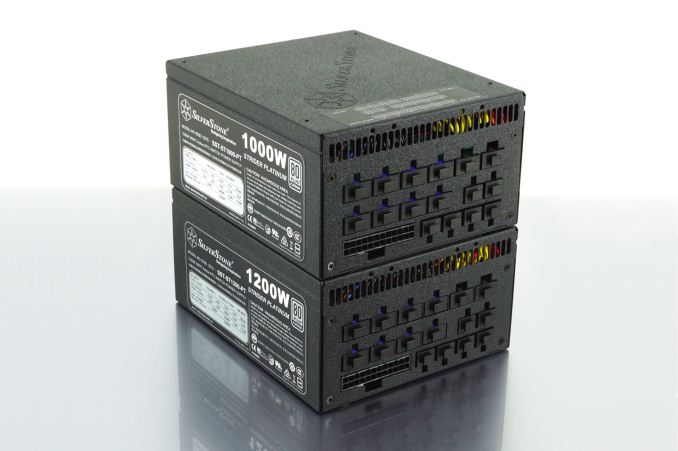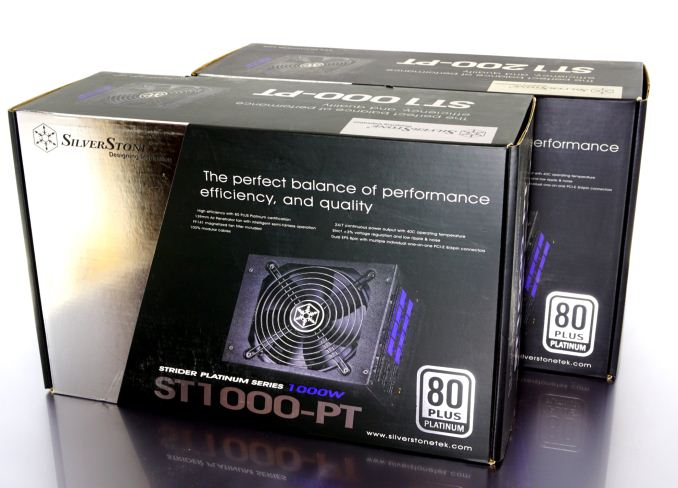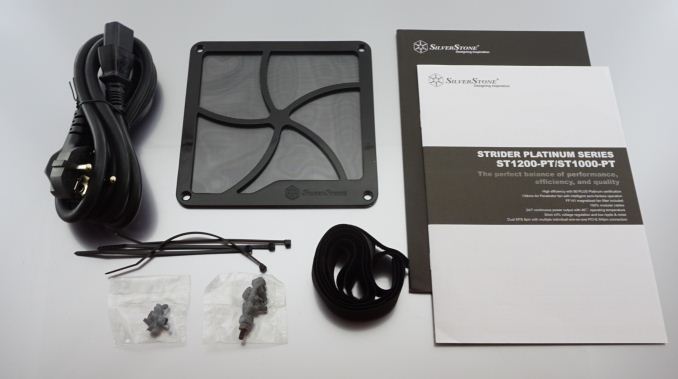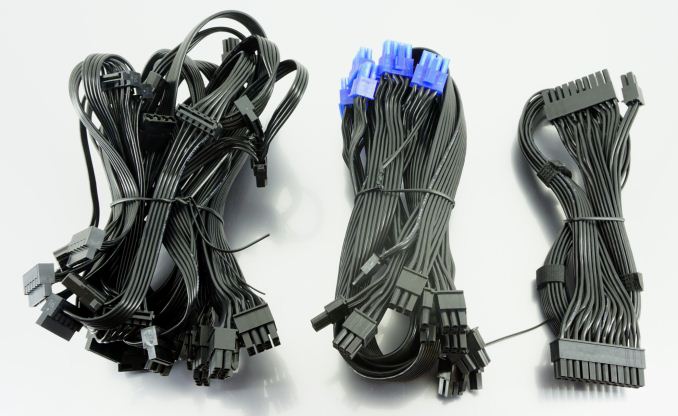The SilverStone Strider Platinum ST1000-PT & ST1200-PT PSU Review: Tenured
by E. Fylladitakis on May 4, 2018 9:00 AM EST- Posted in
- Cases/Cooling/PSUs
- PSUs
- SilverStone
- 80Plus Platinum

SilverStone is one of the most reputable PC chassis and PSU manufacturers, known for their focus on small form factor (SFF) and micro-ATX designs. We have reviewed numerous of their SFX PSU in the past, ranging from the cost-effective ST30SF/ST45SF to the monstrous SX800-LTI with the 0.76kW/l power density. SilverStone also produces several compact cases that do support ATX PSUs but are of limited proportions, leading the company to research methods to reduce the size of their ATX PSUs as well.
Introduction
Today we're taking a look at the Strider Platinum PSU series. The entire series consists of six units, with outputs ranging from 550 to 1200 Watts. We had reviewed the least powerful model of the series two years ago, before the series was expanded with the now two most powerful units of the series, the ST1000-PT and the ST1200-PT, which have a maximum power output of 1000 and 1200 Watts respectively. The SilverStone Strider Platinum are a reasonably-priced upgrade over the Strider Gold S for high-end gaming and workstation PCs, yet more cost-effective than the grand SilverStone Strider Titanium series.
| SilverStone Strider Platinum ST1000-PT ( Rated @ 50 °C ) | |||||
| AC INPUT | 100 - 240 VAC, 50 - 60 Hz | ||||
| RAIL | +3.3V | +5V | +12V | +5Vsb | -12V |
| MAX OUTPUT | 25A | 22A | 83A | 2.5A | 0.3A |
| 120W | 996W | 12.5W | 3.6W | ||
| TOTAL | 1000W | ||||
| SilverStone Strider Platinum ST1200-PT ( Rated @ 50 °C ) | |||||
| AC INPUT | 100 - 240 VAC, 50 - 60 Hz | ||||
| RAIL | +3.3V | +5V | +12V | +5Vsb | -12V |
| MAX OUTPUT | 25A | 22A | 100A | 2.5A | 0.3A |
| 120W | 1200W | 12.5W | 3.6W | ||
| TOTAL | 1200W | ||||
Packaging and bundle
SilverStone supplies the Strider Platinum units inside a very sturdy cardboard box. The artwork is subtle, focused on black/platinum coloring and a picture of the PSU itself. The detailed information regarding the features and specifications of the units is printed on the sides and rear of the box. Inside the box, the PSUs are well-protected between thick packaging foam pieces.
The company supplies a relatively rich bundle along with their SilverStone Platinum units. Both the ST1000-PT and the ST1200-PT share the exact same bundle. Inside the box, we found a very detailed user's manual, a regular AC power cable, black cable ties, black long cable straps, a set of black mounting screws, a set of black thumbscrews, and a magnetic nylon fan filter. The fan filter is meant to protect the PSU from dust but it can be placed anywhere on the case if the PSU's compartment already features a filter.
The ST-1000PT and the ST-1200PT also share the same type of cables and connectors, with the only exception being that the 1200W variant offers two additional PCIe connectors. SilverStone is using flat "ribbon" type cables, made using all black wires and connectors. This includes the ATX cable and the CPU/PCI-E 12V connectors. The only exception at the blue connectors at the PSU side of the PCI Express power cables. The ATX cable is made of several smaller ribbons bundled and secured together, forming a sort-of round cable.
| SilverStone Strider Platinum | ||
| Model | ST1000-PT | ST1200-PT |
| ATX 24 Pin | 1 | 1 |
| EPS 4+4 Pin | 2 | 2 |
| EPS 8 Pin | - | - |
| PCI-E 6+2 Pin | 6 | 8 |
| PCI-E 8 Pin | - | - |
| SATA | 16 | 16 |
| Molex | 6 | 6 |
| Floppy | 2 | 2 |













21 Comments
View All Comments
techguymaxc - Friday, May 4, 2018 - link
I have a PC Power & Cooling 1200W Silencer Mark III that I purchased 5 years ago. It had already been on the market for a year or 2 at that point. It is also 180mm deep. I don't find the following statement to be terribly compelling, or remarkable, in light of this fact: "Both units are 180 mm deep, which is relatively short for units with that kind of power output, yet certainly longer than what the ATX standard dictates."milkywayer - Friday, May 4, 2018 - link
We need more compact SFX PSUs. I understand there is a market for this but it baffles me why I kept using tower cases after having moved to an SFF case which can fit a 1080 ti, 32 gigs of ram, 8700k, two 3.5inch hdd and multiple ssds. All in a case a about 30 the size of my previous case.CheapSushi - Friday, May 4, 2018 - link
I just really want an SFX-L PSU with two EPS connectors for HEDT boards. I really don't care for the size of regular PSU's anymore regardless of what I'm building and what case. It just seems natural that with everything else miniaturizing, getting better, etc, that PSU's should too. Hell, sometimes the PSU's are half the volume of the rest of what takes up the space in an build.close - Monday, May 7, 2018 - link
PSUs are the only component in a PC that have to use some pretty large components like thumb-sized electrolytic capacitors, transformers, chokes, or even the AC socket (by function and design) while also dissipating up to 100+W.Now of course problem might be solved by throwing enough money at it. But would you still like the sticker price?
DanNeely - Monday, May 7, 2018 - link
There're SFX sized PSUs powerful enough to run dual GPUs, so there's no technical reason they couldn't offer 2xEPS connectors instead.I'd suggest @CheapSushi look for a modular design that uses the same 12V connector on the PSU for the EPS and GPU cables; then get 2nd EPS cable for it separately. With full ATX if they use the same PSUside plug or not is hit and miss, so you need to look closely. It should be clear from the markings on the PSU itself though if they're specialized or generic 12V 8 pin sockets.
close - Tuesday, May 8, 2018 - link
Sorry, I somehow read the comment as "I really don't care for the size of [SFX] PSUs anymore". Was wondering how much smaller can they get ant still do the job at a reasonable price.DanNeely - Tuesday, May 8, 2018 - link
There isn't a standard size significantly smaller than SFX. The longer narrower TFX spec might be a better fit for really thin SFF cases, but is only a few percent smaller in internal volume. Below that in size you end up with PicoPSU's and their equivalent which take a 12V (or 19V in some higher power models) external power brick which plugs into a tiny PCB that plugs into the 24pin atx connector and has a handful of other cables branch off from there. Looking at the size of higher powered laptop bricks you probably could make a 1/2 to 1/4 SFX sized internal PSU with a 40/50mm fan for GPUless SFF systems; but with even smaller platforms like NUC eating that segment of the market there probably isn't the demand for it.DanNeely - Tuesday, May 8, 2018 - link
There isn't a standard size significantly smaller than SFX. The longer narrower TFX spec might be a better fit for really thin SFF cases, but is only a few percent smaller in internal volume. Below that in size you end up with PicoPSU's and their equivalent which take a 12V (or 19V in some higher power models) external power brick which plugs into a tiny PCB that plugs into the 24pin atx connector and has a handful of other cables branch off from there. Looking at the size of higher powered laptop bricks you probably could make a 1/2 to 1/4 SFX sized internal PSU with a 40/50mm fan for GPUless SFF systems; but with even smaller platforms like NUC eating that segment of the market there probably isn't the demand for it.CheapSushi - Wednesday, May 9, 2018 - link
Also look into PSU's like FSP's Twins 500W. Two PSU's, redundant, in the same ATX form factor and then tell me power density can't be improved in SFX and SFX-L.CheapSushi - Wednesday, May 9, 2018 - link
One issue is that PSU cables are not standardized. I've seen some SFX PSU's label their port as GPU & CPU. But some other SFX PSU's don't. I've read some people have accidentally screwed up their mobos because of this.As for close, there are SFX-L examples already showing what you can do with density. There's already new improvements taking hold with all digital designs and for example Corsair using Gallium Nitride (GaN) MOSFET's. I am 100% prepared to pay more for better SFX and SFX-L PSU's and as they become the norm and companies focus more on them, price would go down regardless. You're assuming just because parts are larger than power per volume can't get any better. That's not true at all. I just don't see the point of ATX anymore in terms of necessity unless going up to 1500W to 2000W where you do need more space. Almost every single consumer rig, gaming rig and most workstations have enough with SFX and SFX-L. Just my issue is that power cables are NOT standardized, the ports aren't standardized and I can't seem to find an SFX-L with 100% assured confidence that I can use a port for a second EPS.